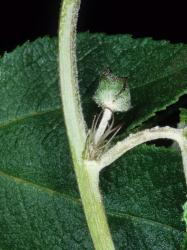- Taxon
- Gallery
Vigorous vine; young shoots angular, downy. Lvs 3-lobed; petioles 1–3 cm long, white-lanate, with (2)–4–8 glands almost hidden in indumentum; stipules pinnate with dark filiform segments almost to the base of the very narrow-linear rachis; lamina lobes 5–9 cm long, extending ?-3/4 distance in from margin; middle lobe largest, 3–8 × 1.5–3 cm, lanceolate to elliptic-ovate, dentate, grey- or white-tomentose below, glabrate above except when young, dark shining green, ± rugose, acute or mucronate. Fls ☿, solitary. Pedicels much > petioles, hairy. Bracts free, 1.5–2.3 cm long, ovate, hairy or glabrate outside, serrate with teeth setose. Hypanthium (4)–4.5–5 cm long, tomentulose. Sepals 3–4.8 cm long, elliptic, green outside, with tomentulose band, white or very pale pink inside, with short horn near apex; petals similar to sepals but all pink; corona threads violet-blue, c. 1/2 perianth. Filaments 1.3–1.7 cm long, much > anthers; anthers 6–9 mm long. Ovary white-villous. Fr. 4–7 cm diam., globose or depressed globose, yellow, tomentulose; pulp sweet and edible, orange. Seeds 5–6 mm long, ellipsoid-ovoid, dark brown or dark red, alveolate.
[From: Webb et al. (1988) Flora of New Zealand. Volume 4.]
Flowering: Jan.–Dec.




